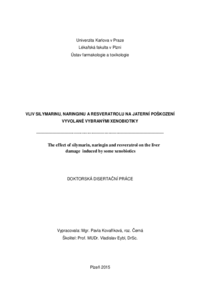Vliv silymarinu, naringinu a resveratrolu na jaterní poškození vyvolané vybranými xenobiotiky
The effect of silymarin, naringin and resveratrol on the liver damage induced by some xenobiotics
dizertační práce (OBHÁJENO)

Zobrazit/
Trvalý odkaz
http://hdl.handle.net/20.500.11956/64629Identifikátory
SIS: 105331
Kolekce
- Kvalifikační práce [312]
Autor
Vedoucí práce
Oponent práce
Anzenbacherová, Eva
Mayer, Otto
Fakulta / součást
Lékařská fakulta v Plzni
Obor
-
Katedra / ústav / klinika
Ústav farmakologie
Datum obhajoby
29. 6. 2015
Nakladatel
Univerzita Karlova, Lékařská fakulta v PlzniJazyk
Čeština
Známka
Prospěl/a
Klíčová slova (česky)
toxické poškození jater, oxidační stres, silymarin, naringin, resveratrolJátra jsou hlavním orgánem metabolismu většiny exogenních látek. Biotransformací xenobiotik vznikají nejen biologicky neaktivní metabolity, ale též reaktivní produkty, které mohou vést k poškození buněčných struktur a následně celého orgánu. V patologii toxického či polékového poškození jater hraje významnou roli také oxidační stres. Endogenní či exogenní antioxidanty pomáhají udržovat rovnováhu mezi vznikem a odstraňováním reaktivních kyslíkových forem a tak zamezují oxidačnímu stresu. V akutních pokusech na potkanech jsme sledovali účinky premedikace přírodních antioxidantů silymarinu (SIL), naringinu (NAR), resveratrolu (RES) a syntetického chelátoru deferipronu (L1) na poškození jater vyvolané paracetamolem (APAP), thioacetamidem (TAA) a tamoxifenem (TAM). Ke stanovení míry poškození jater jsme zvolili měření parametrů oxidačního stresu v jaterních homogenátech: hladina peroxidace lipidů (LP), koncentrace redukovaného glutathionu (GSH), aktivity antioxidačních enzymů glutathion peroxidázy (GPx) a katalázy (CAT), v některých případech byl měřen obsah železa v játrech. Dále byly stanoveny aktivity jaterních enzymů v séru: alanin aminotransferáza (ALT), aspartát aminotransferáza (AST), glutamát dehydrogenáza (GLDH). Z hlediska oxidačního stavu se v toxickém poškození jater nejlépe uplatnil...
The vast majority of exogenous substances is metabolized in the liver. In the course of the biotransformation, partly biologically non-active products, partly reactive species leading to cell structure injury and even to the liver failure are produced. Oxidative stress plays a significant role in the toxic- and drug-induced liver damage. Endogenous and exogenous antioxidants contribute to equilibrium between the production and the elimination of reactive oxygen species and thus prevent the oxidative stress. In acute experiments in rats we examined the ability of natural antioxidants silymarin, naringin and resveratrol and of synthetic chelator deferipron to protect against liver damage induced by paracetamol, thioacetamide and tamoxifen. The following parameters of oxidative stress were measured in the liver homogenates: level of lipid peroxidation (LP), concentration of reduced glutathione (GSH), activities of glutathione peroxidase (GPx) and of catalase (CAT); in some cases the iron liver content. The following markers of liver damage were measured in serum: alanine aminotransferase (ALT), aspartate aminotransferase (AST), glutamate dehydrogenase (GLDH). Concernig markers of oxidative status, silymarin exerted the most efficient antioxidant properties amelioratig the TAA- and TAM-induced lipid...
